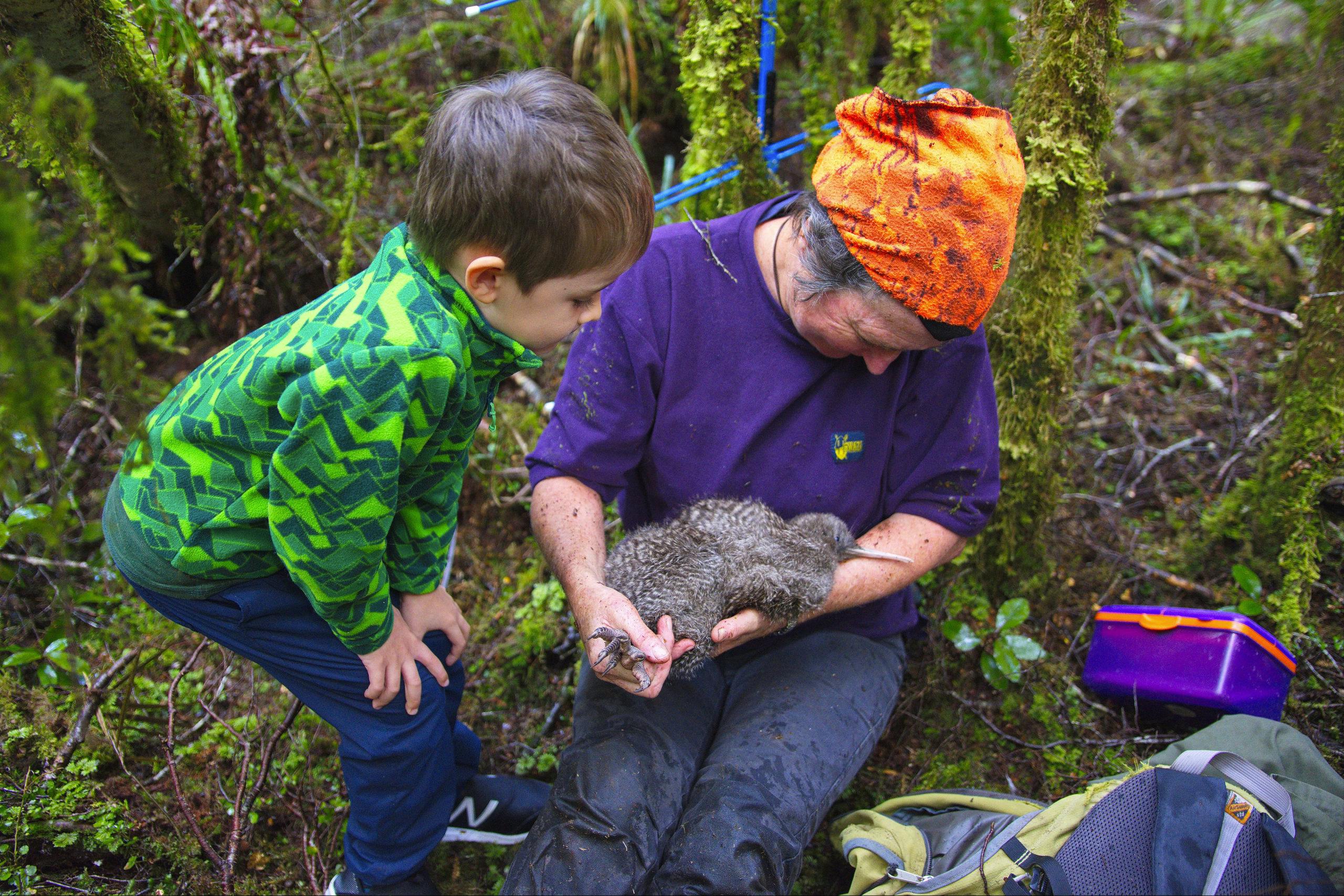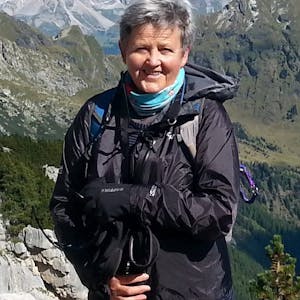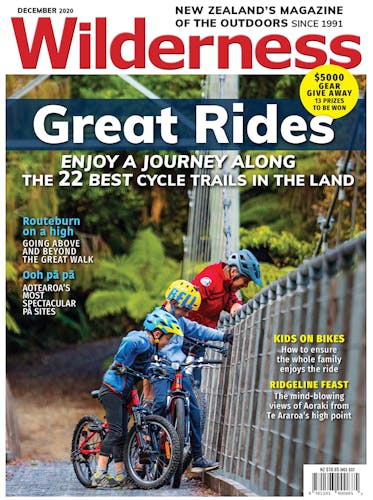The Paparoa Track Great Walk has opened up access to remote backcountry for a hugely expanded predator control programme that is boosting rare great spotted kiwi numbers.
It’s not just Great Walk trampers and bikers coming to Blackball, great spotted kiwi are also joining the party.
“There weren’t any roroa down here 10 years ago, we didn’t expect them to come to town,” Jo Halley says, referring to the kiwi calls they’re now hearing from Blackball as a decade of predator control and Operation Nest Egg makes an impact. “It’s exciting there are so many so close, also that they are breeding with lots of different family groups.”
Halley has been involved with kiwi conservation with the Paparoa Wildlife Trust for 12 years. In October, she handed over the ‘Kiwi Ranger’ reins to Kristy Owens and the role moved from part time to full time.
Before her retirement, Halley took me to the Atarau Sanctuary Kiwi Crèche, near Blackball.
Here, a generous landowner has donated to the trust the use of 12.5ha of regenerating beech forest, all of it now safely enclosed by a 1500m predator-proof fence. Because of predators, stoats in particular, most kiwi chicks born in unmanaged habitat do not survive, hence the ‘crèche’ programmes now established around the country. Roroa eggs are taken from nests in the Paparoa Range and hatched at Willowbank Wildlife Reserve in Christchurch, then the chicks are transferred to this predator-free ‘crèche’. Once big and strong enough to repel predators, the kiwi are released into the wild.
Resident kiwi living in the ranges are generally older and not very productive, so introducing younger birds helps boost the overall population, explains Halley.
“This is the only crèche facility for roroa, which are found in Paparoa, Kahurangi and Arthur’s Pass National Parks. We are effectively trialling Operation Nest Egg for the species,” says Halley. “We work closely with DOC and we share data with everyone involved in roroa conservation. Ngāti Waewae is really supportive,” she adds.
Initially, the trust used Abel Tasman’s Adele Island as a crèche. “While the young birds thrived on the island, they didn’t survive their transfer back to the coast. We were very disappointed, but the scientists encouraged us to keep going.
“Roroa seem to be more susceptible to stress and we now feel if they are older when released into the wild they cope better.”
Since 2010, 34 young kiwi have been released back to the Paparoa Range. The Trust’s Kiwi Ranger continues to monitor their welfare, scrambling through the undergrowth in all weathers to find them. Halley called it her dream job. She was trained for the specialist kiwi role by Halley Tilson, a former DOC ranger who initiated the roroa conservation programme in Paparoa.
The trust began in 2006, driven first by locals wanting to protect dwindling whio populations in the neighbouring Croesus and Moonlight catchments. But when a survey found only three whio remaining, the emphasis shifted to roroa.
Predator control goes hand in hand with the Operation Nest Egg programme, says Halley. “We have trapping networks all over the Roaring Meg Ecological Area, 8500ha of conservation stewardship land adjoining Paparoa National Park. We helicopter the trapping teams to the tops and they make their way down, it makes a huge difference being able to afford to do that.
“We are well supported, we have funding from the DOC Community Fund, Kiwis for kiwi and the Roa Coalmine, which sits on private land above Blackball.”
The funding pays for four part-time trappers, an administrator, the kiwi ranger and for traps and technical gear. There are also five volunteer trustees who are very active.
And while Halley acknowledges the official view that aerial landscape scale 1080 is the key tool for saving species, she says trapping is a vital cog in the trust’s conservation programme.
“We know what we are doing makes a huge difference for other native birds, and the flora as well, and with my former role becoming full time, we should be able get more data on that.”
We arrived at the crèche. The chicks here are usually left alone, but Halley wanted to change a transmitter band on a fast-growing youngster named Najima. Born soon after the Christchurch Mosque attack, the local Muslim community was invited to provide a name. Najima means star (as in, a guiding light in the darkness).
Halley tuned in her transmitter and soon detected a signal. I tried to follow her quietly through the crackling dry undergrowth, but I suspect, to little Najima, I sounded more like an elephant. Then Halley nodded and pointed to a jumble of branches beside a log. We crept closer.
But Najima wasn’t interested in hanging around for a flash new leg band. Sensing his discovery, he emerged into view, scurried over the log, past my foot and into the wilderness, looking pretty strong and independent to me.
“He’s a bit feistier than the other chicks here at the moment,” Halley says. “They’d let me pick them up but they don’t need any kind of health check so we won’t disturb them.”
On our way back to Blackball, Halley pulled over and pointed out two areas, high in the ranges. “Those are new areas we plan to spread the young roroa because the current areas are filling up and the birds are very territorial.
It’s all stewardship land, including some former mining land and regenerating forest, which is good for releasing chicks into because there are no adults already established.”
A DOC Community Grant and Air New Zealand funding is helping with this.
Meanwhile, local whio populations are also growing, says Halley. “DOC has been releasing whio into the Moonlight and they’ve set traps every 100m. They weren’t having much success until the first 1080 drop in the park, in 2014, then three pairs of whio fledged four ducklings each. It was one of the best results in New Zealand that year.”
There’s more good news: “The new Paparoa Track is providing access for extending our trapping lines. We’re going to trap right along Moonlight Ridge and down to the river, where the whio are,” Halley says.
Paparoa Wildlife Trust chair Paul Berry is similarly excited about new biodiversity work on the western Paparoa Range where a DOC and Air New Zealand partnership is now complementing the trust’s work. “They are pledging to install 800 double set traps along 80km of new trap lines over four years, along with an increase in goat control and in monitoring,” he says.
And for the record, Najima was reportedly more obliging a few days after my visit, and now sports a new, larger leg band.
It’s not just Great Walk trampers and bikers coming to Blackball, great spotted kiwi are also joining the party.
“There weren’t any roroa down here 10 years ago, we didn’t expect them to come to town,” Jo Halley says, referring to the kiwi calls they’re now hearing from Blackball as a decade of predator control and Operation Nest Egg makes an impact. “It’s exciting there are so many so close, also that they are breeding with lots of different family groups.”
Halley has been involved with kiwi conservation with the Paparoa Wildlife Trust for 12 years. In October, she handed over the ‘Kiwi Ranger’ reins to Kristy Owens and the role moved from part time to full time.
Before her retirement, Halley took me to the Atarau Sanctuary Kiwi Crèche, near Blackball.
Here, a generous landowner has donated to the trust the use of 12.5ha of regenerating beech forest, all of it now safely enclosed by a 1500m predator-proof fence. Because of predators, stoats in particular, most kiwi chicks born in unmanaged habitat do not survive, hence the ‘crèche’ programmes now established around the country. Roroa eggs are taken from nests in the Paparoa Range and hatched at Willowbank Wildlife Reserve in Christchurch, then the chicks are transferred to this predator-free ‘crèche’. Once big and strong enough to repel predators, the kiwi are released into the wild.
Resident kiwi living in the ranges are generally older and not very productive, so introducing younger birds helps boost the overall population, explains Halley.
“This is the only crèche facility for roroa, which are found in Paparoa, Kahurangi and Arthur’s Pass National Parks. We are effectively trialling Operation Nest Egg for the species,” says Halley. “We work closely with DOC and we share data with everyone involved in roroa conservation. Ngāti Waewae is really supportive,” she adds.
Initially, the trust used Abel Tasman’s Adele Island as a crèche. “While the young birds thrived on the island, they didn’t survive their transfer back to the coast. We were very disappointed, but the scientists encouraged us to keep going.
“Roroa seem to be more susceptible to stress and we now feel if they are older when released into the wild they cope better.”
Since 2010, 34 young kiwi have been released back to the Paparoa Range. The Trust’s Kiwi Ranger continues to monitor their welfare, scrambling through the undergrowth in all weathers to find them. Halley called it her dream job. She was trained for the specialist kiwi role by Halley Tilson, a former DOC ranger who initiated the roroa conservation programme in Paparoa.
The trust began in 2006, driven first by locals wanting to protect dwindling whio populations in the neighbouring Croesus and Moonlight catchments. But when a survey found only three whio remaining, the emphasis shifted to roroa.
Predator control goes hand in hand with the Operation Nest Egg programme, says Halley. “We have trapping networks all over the Roaring Meg Ecological Area, 8500ha of conservation stewardship land adjoining Paparoa National Park. We helicopter the trapping teams to the tops and they make their way down, it makes a huge difference being able to afford to do that.
“We are well supported, we have funding from the DOC Community Fund, Kiwis for kiwi and the Roa Coalmine, which sits on private land above Blackball.”
The funding pays for four part-time trappers, an administrator, the kiwi ranger and for traps and technical gear. There are also five volunteer trustees who are very active.
And while Halley acknowledges the official view that aerial landscape scale 1080 is the key tool for saving species, she says trapping is a vital cog in the trust’s conservation programme.
“We know what we are doing makes a huge difference for other native birds, and the flora as well, and with my former role becoming full time, we should be able get more data on that.”
We arrived at the crèche. The chicks here are usually left alone, but Halley wanted to change a transmitter band on a fast-growing youngster named Najima. Born soon after the Christchurch Mosque attack, the local Muslim community was invited to provide a name. Najima means star (as in, a guiding light in the darkness).
Halley tuned in her transmitter and soon detected a signal. I tried to follow her quietly through the crackling dry undergrowth, but I suspect, to little Najima, I sounded more like an elephant. Then Halley nodded and pointed to a jumble of branches beside a log. We crept closer.
But Najima wasn’t interested in hanging around for a flash new leg band. Sensing his discovery, he emerged into view, scurried over the log, past my foot and into the wilderness, looking pretty strong and independent to me.
“He’s a bit feistier than the other chicks here at the moment,” Halley says. “They’d let me pick them up but they don’t need any kind of health check so we won’t disturb them.”
On our way back to Blackball, Halley pulled over and pointed out two areas, high in the ranges. “Those are new areas we plan to spread the young roroa because the current areas are filling up and the birds are very territorial.
It’s all stewardship land, including some former mining land and regenerating forest, which is good for releasing chicks into because there are no adults already established.”
A DOC Community Grant and Air New Zealand funding is helping with this.
Meanwhile, local whio populations are also growing, says Halley. “DOC has been releasing whio into the Moonlight and they’ve set traps every 100m. They weren’t having much success until the first 1080 drop in the park, in 2014, then three pairs of whio fledged four ducklings each. It was one of the best results in New Zealand that year.”
There’s more good news: “The new Paparoa Track is providing access for extending our trapping lines. We’re going to trap right along Moonlight Ridge and down to the river, where the whio are,” Halley says.
Paparoa Wildlife Trust chair Paul Berry is similarly excited about new biodiversity work on the western Paparoa Range where a DOC and Air New Zealand partnership is now complementing the trust’s work. “They are pledging to install 800 double set traps along 80km of new trap lines over four years, along with an increase in goat control and in monitoring,” he says.
And for the record, Najima was reportedly more obliging a few days after my visit, and now sports a new, larger leg band.








